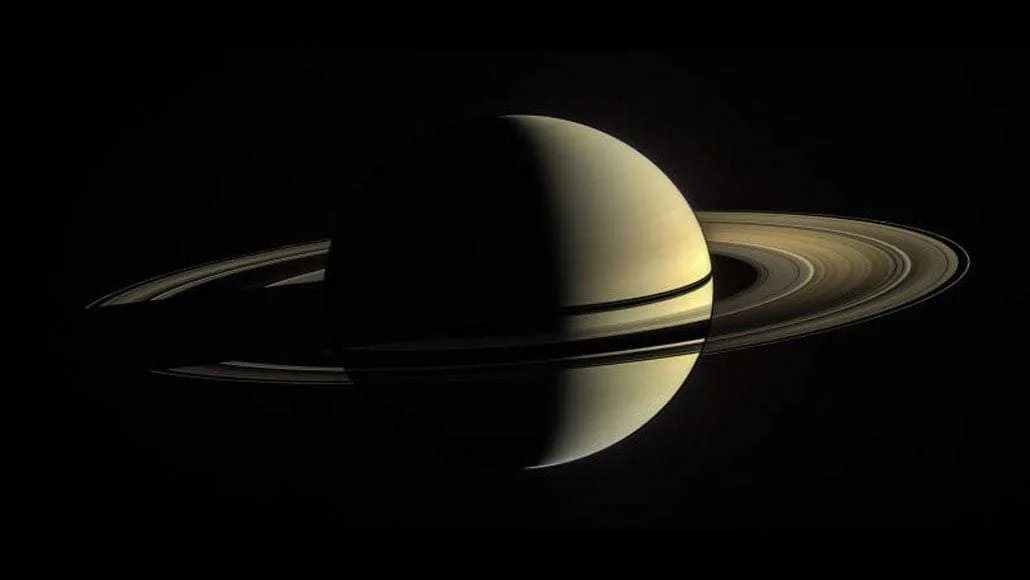One of Saturn’s rings has revealed properties of its core, hidden deep beneath the planet’s golden atmosphere.
That core isn’t the lump of rock and ice that many scientists had envisioned, the new study finds. Instead, the core is diffuse, pervaded by huge amounts of hydrogen and helium and so spread out that it spans 70,000 kilometers, or about 60 percent of the planet’s diameter, researchers report April 28 at arXiv.org.
The new intel should help planetary scientists better understand not only how giant planets formed in our solar system but also the nature of such worlds orbiting other stars.
To ascertain the structure of Saturn’s core, astronomer Christopher Mankovich and astrophysicist Jim Fuller, both at Caltech, examined the giant planet’s rings. Just as earthquakes help seismologists probe Earth’s interior, oscillations inside Saturn can reveal its internal composition. These oscillations alter Saturn’s gravitational forces, inducing waves in the rings —especially the C ring, which is the nearest of the three main rings to the planet (SN: 1/22/19).
By analyzing a wave in that ring, along with data on Saturn’s gravity field from the now-defunct Cassini spacecraft (SN: 9/15/17), Mankovich and Fuller found that the core has about 17 Earth masses of rock and ice. But there’s so much hydrogen and helium mixed in, the core encompasses 55 Earth masses altogether — more than half of Saturn’s total, which is equivalent to the mass of 95 Earths. This “ring seismology” work will appear in a future Nature Astronomy.
“It’s a new way to look at gas giant planets in the solar system,” says Ravit Helled, a planetary scientist at the University of Zurich who was not involved with the work. “This knowledge is important because it reflects on our understanding of giant exoplanets,” and indicates that giant planets in other solar systems probably have more complex structures than many researchers had thought.
The discovery also illuminates how Saturn formed, says Nadine Nettelmann, a planetary scientist at the German Aerospace Center in Berlin.
Older theories posited that a gas giant such as Saturn arises when rock and ice orbiting the sun start to conglomerate. Tenuous gaseous envelopes let additional solid materials sink to the center, forming a compact core. Only later, according to this theory, does the core attract lots of hydrogen and helium — the ingredients that make up most of the planet. Although these elements are gases on Earth, Saturn’s great gravity squeezes most of them into a fluid.
But newer theories say instead that plenty of gas got incorporated into the core of rock and ice when it was taking shape 4.6 billion years ago. As the planet accreted additional mass, the proportion of gas rose. The structure Mankovich and Fuller deduce for Saturn’s core preserves this formation history, Nettelmann says, because the planet’s very center, representing the oldest part of Saturn, has the greatest proportion of rock and ice. The fraction of rock and ice decrease gradually rather than abruptly from the core’s center to its edge, reflecting the core’s development over time.
“I find the conclusions very important and very exciting and the line of reasoning very convincing,” Nettelmann says. Still, she cautions that additional waves in the rings should be analyzed for confirmation.
The type of oscillation that Mankovich and Fuller detect inside Saturn also implies that the core is stable rather than bubbling like a pot of water on a hot stove, which is one way a planet can carry heat from its hot interior outward. The core’s stability may help explain a long-standing puzzle: why Saturn emits more energy than it gets from the sun.
After the planet formed, it was warm with the heat of its birth, but then it cooled off. The core’s stability could have put a lid on some of this cooling, however, which helped the planet retain heat that it still radiates to this day. In contrast, if the core had instead transported heat via the upwelling and downwelling of material, the planet would have cooled off faster and no longer give off so much heat.
Source : Saturn’s fuzzy core spreads over more than half the planet’s diameter | Science News







